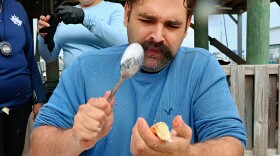RACHEL MARTIN, HOST:
For more than a month, demonstrators have been on the streets of St. Louis to protest the not-guilty verdict in the trial of Jason Stockley. He's the white officer who shot and killed a black man, Anthony Lamar Smith, six years ago. As St. Louis Public Radio's Willis Ryder Arnold reports, the city's police have come under scrutiny for tactics used to disperse crowds.
WILLIS RYDER ARNOLD, BYLINE: A few times every week, protesters march throughout parts of St. Louis. At a recent rally, they're shouting the names of black people killed by police.
(SOUNDBITE OF PROTEST)
UNIDENTIFIED PROTESTER #1: My name is Mike Brown. My name is...
UNIDENTIFIED PROTESTER #2: My name is Kajieme Powell.
ARNOLD: This protest is one of many held to condemn the acquittal of former St. Louis Police Officer Jason Stockley who shot and killed Anthony Lamar Smith, a black man he suspected of dealing drugs in north St. Louis six years ago. Michelle Shaw says she's here to try and hold police accountable.
MICHELLE SHAW: Instead of literally lynching us, they're just shooting us down with guns. What's the use of tasers? What's the use of mace? What's the use of de-escalation tactics? What's the use of that if you're going to just pull your gun out and shoot somebody down?
ARNOLD: Protests have targeted majority-white areas of the city in an effort to engage people whose lives are rarely directly affected by police shootings. Demands include implementing stricter use-of-force policies. Yet the protestors' primary demand runs the deepest - the demands reflected in the chant, y'all gonna stop killing us.
(SOUNDBITE OF PROTEST)
UNIDENTIFIED PROTESTERS: Ya'll gonna stop killing us.
UNIDENTIFIED PROTESTER #3: Ya'll gonna stop killing us.
UNIDENTIFIED PROTESTERS: Ya'll gonna stop killing us.
ARNOLD: More than 300 arrests have been made. And the police here have been criticized for using pepper spray and tear gas on crowds and also for throwing people to the ground while making arrests. They're also doing so-called kettling, a procedure where they block people from leaving a specific location before making arrests. That means protests now include complaints against the police for their actions during protests just like this one.
First Amendment scholar Greg Megarian finds that troubling...
ARNOLD: ...Because if the people can't protest against literally what the government is doing on the street in the form of law enforcement then the First Amendment doesn't really mean much at all.
ARNOLD: But Valery Ems, whose husband is a police officer, calls the protests ineffectual and says she's worried they'll turn violent.
VALERY EMS: Tensions are high. And even protests that start out peaceful - I think they can turn in an instant. And it's tough to know what's going to happen.
ARNOLD: Protesters also want St. Louis Mayor Lyda Krewson to step down. While the mayor's not addressing that demand, she says she's pushing for police to receive more de-escalation training.
LYDA KREWSON: Use the minimal amount of force possible. And really, we are just there to protect the protesters' First Amendment rights to protest, which is the hallmark of our democracy.
ARNOLD: As today's protest comes to a close, activist and organizer Tory Russell compares this bit of civil disobedience to the Boston Tea Party nearly two and a half centuries ago.
TORY RUSSELL: It's just as American as apple pie. And so if you don't like the prostest, you don't love the Constitution. You damn sure don't love America.
ARNOLD: Russell and others initially called for 100 days of action following the Stockley verdict. They now say protests will continue here indefinitely - at least until they see a measurable change to St. Louis Police Department's use of force policies. For NPR News, I'm Willis Ryder Arnold in St. Louis. Transcript provided by NPR, Copyright NPR.







